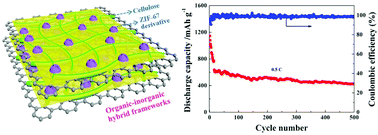Effective accommodation and conversion of polysulfides using organic–inorganic hybrid frameworks for long-life lithium–sulfur batteries†
Abstract
Lithium–sulfur (Li–S) batteries are one of the most promising candidates for meeting the emerging market demands for energy storage, and have the advantages including high energy density and low cost. However, the practical application of Li–S batteries is hindered by the lithium polysulfide (LiPS) shuttle, which induces low sulfur utilization and unsatisfactory capacity retention. To address this problem, recent studies have focused on improving the transformation of LiPS into insoluble Li2S2/Li2S through methods beyond physical or chemical adsorption. Nevertheless, the commonly used host materials have limited ability to simultaneously trap and propel redox transfer of LiPS. Herein, the bottom-up construction of new organic–inorganic hybrid frameworks for sulfur cathodes is proposed to fundamentally restrict LiPS dissolution and enhance their electrochemical transformation. The synergistic integration of organic cellulose networks and inorganic ZIF-derivatives caused highly efficient LiPS mediators to suppress the shuttle effect and retain electrode stability. The resulting RCE-Co3O4@G-S cathode materials delivered a stable capacity of 726.5 mA h g−1 at 0.2 C after 350 cycles, with a very low fading rate of 0.026% per cycle and a high coulombic efficiency of 98.9%.



 Please wait while we load your content...
Please wait while we load your content...